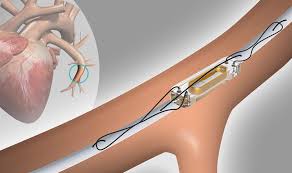 Measures and monitors the pulmonary artery (PA) pressure and heart rate in heart failure patients.
Measures and monitors the pulmonary artery (PA) pressure and heart rate in heart failure patients.
The System consists of an implantable pulmonary artery sensor, delivery system, and Patient Electronics System.
The implantable sensor is permanently placed in the pulmonary artery, the blood vessel that moves blood from the heart to the lungs.
The sensor is implanted during a right heart catheterization procedure.
The PA sensor is small thin and has a curved wire at each end.
This sensor does not require any batteries or wires.
The delivery system is a long flexible catheter is designed to release the implantable sensor in the far end of the pulmonary artery.
The Patient Electronics System reads the PA pressure measurements from the sensor wirelessly and then transmits the information.
The antenna is paddle-shaped and is inside a pillow to make more comfortable for the patient to take readings.
The sensor monitors the pressure in the pulmonary artery permitting medication changes to help treat heart failure.
The system is used to wirelessly measure and monitor PA pressure and heart rate in New York Heart Association (NYHA) Class III heart failure patients who have been hospitalized for heart failure in the previous year.
The PA pressure and heart rate are used for heart failure management and with the goal of reducing heart failure hospitalizations.
In a clinical study in which 550 participants had the device implanted, there was a clinically and statistically significant reduction in heart failure-related hospitalizations for the participants whose doctors had access to PA pressure data.
The System is contraindicated for those patients who are unable to take anticoagulants for one month after the sensor is implanted.
In the CHAMPION study of patients with heart failure with PA pressure readings noted a 33% difference in admission rates in patients compared with physicians thatdid not have access to pulmonary artery sensor values.
